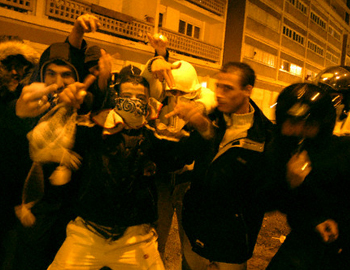Globe
Inside Paris’ Suburban Ghettos
SAINT-DENIS, France – It wasn’t long into my “discrete” photo and note-taking expedition before one of the youth loitering nearby approached in suspicion.
“People are always taking photographs around here,” he said. “They should stick to photographing the districts of Paris.” I’d been warned that Saint-Denis residents are generally suspicious of the media. But after this encounter I was sure of it.
The towering Les Francs-Moisins housing projects in this Paris suburb aren’t exactly picturesque. The once-modern housing complexes now feature rows of buildings with decaying block walls, graffiti-filled stairwells, over-flowing trash bins, rodent infestations and pools of fetid water. Mail deliverers wear helmets here and police are hesitant to patrol the neighborhoods, fearing gang attacks. The conditions are a far cry from even the worst living circumstances in Paris, its neighbor to the south west.
In 2005, Saint-Denis was the epicenter of violent riots in which young men torched cars, burned local facilities and fired shots at police over the accidental electrocution of two teenagers. The community suspected the teenagers had been chased to a power substation by police. Many of the rioters were born here to immigrants from France’s former North African colonies, and are French citizens.
The Saint-Denis riot was one of several occurring in Paris’ suburban ghettos, or “les cites,” during the three-week violent episode. The riots started as an angry response to years of overzealous police tactics against ghetto youth, but quickly became a destructive protest against poverty, unemployment, racial discrimination, poor education and substandard housing. In the end, a reported 10,000 cars were burned and 300 buildings were firebombed and more than 200 police were injured.
“Young people experience a lot of problems with the police,” says Fouad, from Paris, who did not want to give a surname. “It’s always the same police who control them and they are bored of being controlled in their neighborhoods and being taken to police cars. Things are turning to vinegar (a French expression to say things are turning bad).”
Now, as France welcomes a new president, important questions remain about how to best integrate into French society the hundreds of thousands of French-born descendents of Algerian, Moroccan and Tunisian immigrants in Paris’ crumbling suburbs, who say they lack job opportunities, adequate housing and equal treatment by police. Nicolas Sarkozy, France’s new president, is also confronted with the task of easing the longstanding mistrust between traditional French citizens and Muslim immigrants, and with overcoming his own rocky history with France’s Arab and black youth.
The France riots captured global attention and became an embarrassing moment for the French government. To prevent any resurgence in the violence, then-French President Jacques Chirac vowed to create opportunities for young people, announcing plans for additional job training for 50,000 youths by this year.
Currently, France has one of the highest unemployment rates in Europe: 8.7%. In the suburban ghettos, the unemployment rate is estimated to be as high as 40%. Community residents also say racism in France, where an ethnic name or an address to a les cites apartment sends your resume to the trash, is partly to blame for the large job disparity.
“If the gap between rich and poor increases there will be riots in the suburbs again,” says Valerie Thomas, a resident of Le Perreux-sur-Marne, an eastern suburb of Paris. “Sarkozy must do everything he has promised for the poor people. Social measures are also important for a better ambiance and for the mood of the people.”
Thomas says the youth also contribute to the ridged conditions in the neighborhoods when rioting. “The motivation of burning cars is that they are fed up with their living conditions, but it’s stupid because they burn cars of their neighborhoods, which increases their poverty.”The immigrant families of the suburban ghettos also bemoan France’s secular approach to Islam. For example, a 2004 law banning Islamic head scarves in public schools sparked an outcry in immigrant communities, including massive protests. Lawmakers said the law was designed to promote French secularism and will aid the country’s efforts to integrate many of its estimated 5 million Muslims into society. To be sure, the law also banned Jewish skull caps, Sikh head turbans and large Christian crosses.
The Great Saint-Denis Migration
Despite its current shortcomings, Saint-Denis, with a population of about 95,000, has a rich history. Many French kings were buried in Saint-Denis, which is home to several architecturally-rich cathedrals. Scholars say French heroine Joan of Arc blessed her weapons there. French impressionist Claude Monet even depicted the famous Paris street that leads to Saint-Denis in his 1878 Rue Saint-Denis painting.
The housing projects in France were built in the 1950s and 1960s to accommodate the hoards of immigrants who were ushered into the county to support the government’s postwar expansion. Working-class families from Paris also moved to the suburbs, seeking refugee from cramped houses and tenements in the city. And for awhile, the urban planning initiative was working. The working-class French and the immigrants lived comfortably in the suburbs with the support of the industrial jobs. But soon, those industrial jobs diminished and many French-born citizens moved out of government housing. By the 1980s, the economic and living conditions in the suburbs had severely deteriorated.
Sarko’s Task
Ironically, President Sarkozy, whose father was a Hungarian immigrant, has had a tense relationship with the suburban immigrant neighborhoods. Days before the 2005 riots, while serving as French Interior Minister, Sarkozy enraged the suburban communities by referring to some petty criminals as “scum.” Some say Sarkozy’s tough talk may have exacerbated the situation. And his coining of the French slogan “France, love it or leave it,” hasn’t earned Sarkozy many friends in those neighborhoods either. What’s more, Sarkozy didn’t campaign heavily in Saint-Denis or other suburban immigrant neighborhoods, nor did he back down from his earlier statements. His opponent, Segolene Royal, even foreshadowed (if not incited) the sprinkles of violence that occurred following Sarkozy’s election victory.
“It’s Sarkozy’s fault,” says Jean from Ivry-sur-Seine, a suburb north of Paris. “His comment about hosing the scum off the streets is typical of his confrontational attitude.”
But to many, Sarkozy, who is often compared to former New York Mayor Rudolph Giuliani, presented better ideas on the issue of immigrant integration. Building on earlier promises from his predecessor, Sarkozy called for a massive job training program and other campaigns to be used as a deterrent to violent behavior. In earlier roles, Sarkozy has also supported the creation of the French Council of the Muslim Faith that gave Muslims a voice in France. He’s also a supporter of affirmative action and has supported easing rules that restrict government funds for building mosques.
“The solution must be to send people to look after the young people,” says Thomas, from Le Perreux-sur-Marne. “Educators are very important to motivate them to success in their lives, to give them a taste for work.”
Other government programs encourage home ownership as a way for people to escape poverty and earn a stake in society. To make way for the plan, housing towers in some suburbs are being replaced in the suburbs with single-family homes with reasonable mortgage payments.
As I strolled through Saint-Denis, I could see the construction of luxury apartment complexes that overlook the canal. With a dearth of shops, cultural specs and cafés, new residents could be critical to luring more businesses to the suburbs.
Youth Expression
I interviewed Claudie Jouadon, who counsels youth in Saint-Denis as part of the La Cathode documentary film project. Under the project, suburban youth share their often unheard ideas and views on the conditions in les cites. Thus far, Jouadon has made five such films, which are designed to address many of the stereotypes about the suburban youth. She says the backlash over the problems in the suburban ghettos began with the 1981 “rodeo” riots in Les Minguettes, a suburb of Lyon.Those riots put the national spotlight on the suburban conditions, Jouadon said, leading to a march for equal rights.
Jouadon also recalled protecting several youth following incidents with the police. She says the youth are often afraid to leave her following the incidents, which can involve flashing helicopters lights and high-speed foot chases.
“The growth of the suburbs was immense” says Jouadon, adding that the violence can also be barrier to a good education for many in the ghetto communities. Teachers, for example, are sometimes fearful of working in the neighborhood, or the “quartiers chaude,” she says.
Akin to their American counterparts, French artists have rapped for years about the drugs, racism and despair that are prevalent in their communities. They also appeal to a multicultural audience across all racial lines. Weeks after the 2005 riots, several rap artists faced legal sanctions after a conservative lawmaker claimed they encouraged the violence with songs expressing hatred for France. Former French Prime Minster Dominique de Villepin later debunked the claim.
French rap artists use music as a vehicle for expressing their views on police relations, French alienation and the hopeless reality for many in the suburbs.
Disiz La Peste, a 27 year-old of Senegalese and French heritage, raps on “The Stories of a Youth in The Banlieue,” about being accepted in France.
“For France it matters nothing what I do/In its mind I will always be/ Just a youth from banlieue (the suburbs).”






